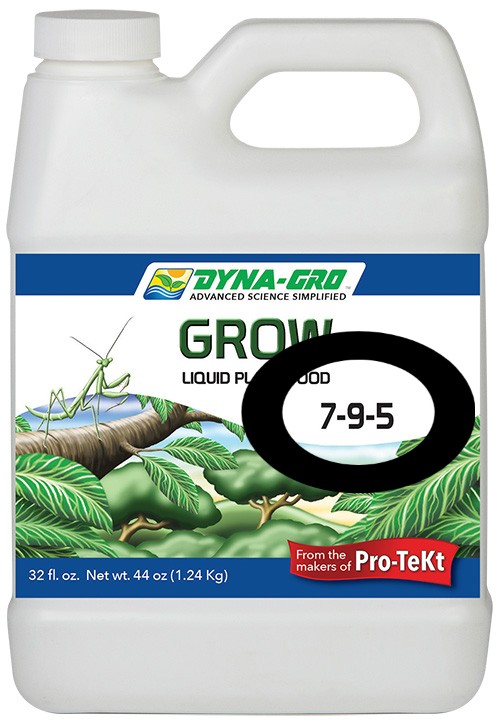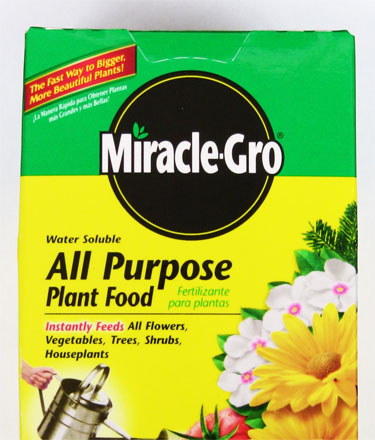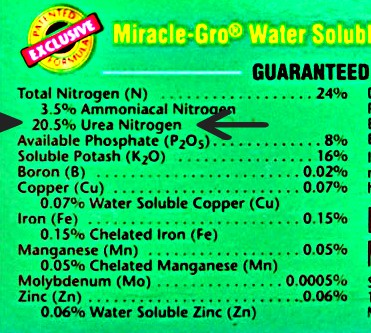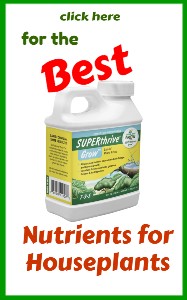Fertilizer (or Nutrients) for Houseplants
In nature, houseplants live in a tropical forest where their roots grow in a combination of soil, decaying leaves, and animal droppings. A virtual smorgasbord of nutrients!
Live bacteria, enzymes, and microbes break down this organic matter into minerals the plants can absorb.
This process is almost impossible with potted plants. Potting materials are sterilized, killing the bacteria, enzymes, and microbes needed to transform organic matter into a form your plants can use.
Potted plants rely on you, the grower, to provide nutritional elements.
|
Is It Plant Food or Fertilizer? Don't confuse "plant food" with "plant fertilizer". Using energy from the sun, plants combine air, light, and water to make carbohydrates, which is the real food they use for growth. "Plant fertilizer (or nutrients)", on the other hand, are mineral elements collected by the roots and used to enhance photosynthesis. Plant fertilizer (or nutrients) cannot compensate for the lack of real food plants need for growth - air, light, and water. |
|
If your plants aren't getting the real food they use for growth - air, light, and water - your choice of fertilizer won't matter. |
What to Look For When Choosing Fertilizers
Choosing the right fertilizer for your plants can make your head spin! Don't get overwhelmed - this doesn't need to be complicated.
Fortunately, manufacturers are required to follow a set of rules and when listing the ingredients inside the package.
Comparing fertilizers isn't difficult when you know how to read the label.
There are 3 things to look for when choosing a fertilizer for growing in LECA (clay aggregate).
1. What are the numbers on the front of the package?
2. Does the fertilizer contain Urea?
3. Are all 11 micro-nutrients plants use for growth in there?
1. The Numbers on the Front of the Package?
All fertilizers contain three main ingredients - Nitrogen (N), Phosphorus (P), and Potash (K).
The numbers on the front panel describe what percentage of each element is in the fertilizer. This is called the "NPK" ratio.
For example, if your fertilizer has 8-9-5 on the front panel, it contains 8% nitrogen, 9% Phosphorus, and 5% Potash.
These numbers can vary, but should be 5 and 10 and relatively even. Then you have a "balanced" fertilizer".
 The numbers on the front of the package
The numbers on the front of the package2. Does It Contain Urea?
Look on the back panel. The first ingredient will be nitrogen. If you see the word "urea" as the source of nitrogen, you don't have a quality fertilizer.
Why?
Houseplants can't use urea! Urea is a cheap form of nitrogen that many fertilizers use to cut costs. Urea can't be absorbed by your plants until it is broken down by enzymes or bacteria. Most hydroponic systems use LECA as the growing media. LECA is a sterile ceramic that won't convert urea based nitrogen into something your plants can use. (Sterilized soil mixes can't convert urea based nitrogen either.)
Unused urea eventually turns to salt which can damage the plant's roots. So if you're using a plant food that has urea on the label you might actually be harming your plants!
Look for "nitrate nitrogen" or "ammoniacal nitrogen" as the source for nitrogen. Then you have the good stuff.
 Popular Fertilizer Popular Fertilizer |
 But it contains urea! But it contains urea! Not good! |
3. Are all 11 Trace Elements Plants Use for Growth in There?
You should see 11 trace elements listed on the back panel. Most fertilizers skimp on these because they rely on the growing media to supply them.
If your fertilizer doesn't have a total of 14 elements listed on the back panel, you're taking a hit-or-miss approach and your plants are missing important minerals.
|
Don't think there's a difference in fertilizers? Ask your plants! |
What About Organic Fertilizers?
Organic means "the nutrient contained in the product is derived solely from the remains of once living organisms". Living organisms include animal waste, crop residue, compost and numerous other byproducts.
Organic fertilizers sound good but most are incomplete in nutritional value. They usually contain only one or two nutritional elements so blending different products is necessary. The result is uncontrollable, difficult to measure, and usually carries an odor. You never really know what your plants are getting.
Earthworm castings, seaweed, and bat guano head the list of organic remedies. Do you really want to put this stuff on your plants, and in your home?
Why take a chance when complete, balanced nutrition is so easy with other brands on the market?
Hydroponic Advantage: Hydroponics doesn't rely on the growing media for any nutrition value. That means "hydroponic nutrients" will always have all the elements your plants need for healthy growth - in a form your plants can use - immediately.
A complete, balanced nutrition program is easy. Just add a couple of drops of nutrients to the water and your plants will be getting everything they need.
With hydroponics the nutrients you add to the water will go directly to the plant - without the soil getting in the way.


